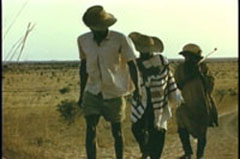Jaguar

In Jaguar, Damoure, Lam and Illo play the roles of young Africans who, at that time, migrated from the interior during the dry season to the Gold Coast in search of work. Their picuresque and rambling adventures along the way provide the antic story-line of the film. The different episodes of the film were worked out by the actors at the time of shooting. Lam (the herdsman), Illo (the fisherman) and Damoure (unsettled but literate) trek south through Dahomey to Ghana, crossing the “Land of the Somba,” enjoying coconuts, the ocean and starfish. They part ways: Damoure and Illo go to Accra where they find work as a dockworker and lumberman while Lam goes to Kumasi and works as a cattle herder for a butcher. Eventually, they regroup in Kumasi and with another friend, set up a stall in the market called “Petit a Petit.” They have succeeded at becoming “jaguars” or townboys with fancy hairdos, sunglasses, cigarettes and money. Nonetheless, they are homesick and return to Niger before the rains, happy to be reunited with their family, friends and familiar landscape.
Directors
Jean Rouch
Jean Rouch (b. 1917) breakthrough work in cinema verite in the 1960s helped inspire the direct cinema movement in the U.S. and the nouvelle vague (new wave) in France where he was a key figure in the cinemateque francaise and the founding director of the Comite du Film Ethnographique at the Musee de I'Homme. His African work, characterized by innovations such as “shared anthropology”' and “ethno-fiction”, is noted for its embrace of both the daily life and imagination of a new generation of Africans. He also played an active role in helping to launch African cinema.
